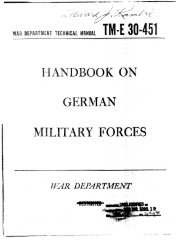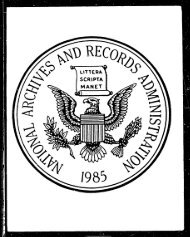miRS-tonpon - Sturmpanzer.com
miRS-tonpon - Sturmpanzer.com
miRS-tonpon - Sturmpanzer.com
You also want an ePaper? Increase the reach of your titles
YUMPU automatically turns print PDFs into web optimized ePapers that Google loves.
__ n be <strong>com</strong>mitted to work by order of its chiefanywhere in Greater Germany and in annexed or occupiedcountries.3« Glauses 1 and 2 also apply to all transport organisationsassigned to the OT.4. The head of the OT will issue directives for the internalorganisation of the OT.At the same time the OTZ was removed from under the InspectorateGeneral of German Roadways and became an office in its own rightwithin SPEER f s Ministry.8. QT 1942 - 1943Internal re-organisation was not the only change which the OTunderwent during a period from May 1942 to late 1943* The status ofthe Organisation itself was revised so that it was included within thepriority scheme of war production which by the winter of 1943/44 haden<strong>com</strong>passed the entire resources of the production machinery ofGermany and occupied territory and to the highest degree that inWestern Europe. During this period of stabilisation on the WesternFront, the greater part of the OT lost its character as a para-militaryengineer corps and became, in essence, a defense industry, constructingnot only military installations, but be<strong>com</strong>ing more and more involvedin the repair of air raid damage to vital <strong>com</strong>munications and essentialwar production plants, and in the construction of new and extensiveunderground depots, factories and other subterranean installations.It can therefore be pointed out that, from* the economic standpointthe OT became subject to the policies dictated by two public figures.One is the policy dictated by Albert SFEER in regard to the<strong>com</strong>parative priority in supplies allotted to the various armamentindustries, including OT's great constructional tasks such as theAtlantic Wall begun in May 1942* The other is the policy dictatedby SS-Obergruppenfuhrer Fritz SAUGKEL the Generalbevollm&chtigterfur den Arbeitseinsatz (Plenipotentiary-General for Manpower Allocation)in regard to <strong>com</strong>parative priority in manpower allotment. SFEERand SAUCKEL are at present the two dominant personalities inGerman war economy.9. SPEER's CareerProfessor Albert SPEER's background and career, except for hislack of military experience, is reminiscent of that of Fritz TQDT.Like TODT's, SPEER's early career was in the field of construction.But, whereas TODT's special interest lay in methods of engineeringtechnique, SHEER's early interest, was in architectural planning andornamentation. He was born 19th March 1905 in MANNHEIM, Baden andattended the Technical Institutes at KARLSRUHE, MJNCHEN, and BERLIN.He obtained his engineering degree (Dipl. Ing.) from the latter, andstayed on for three years as a research student and faculty assistant.SPEER joined the Nazi Party <strong>com</strong>paratively late in 1932, and formed apersonal friendship with both HITLER and GOERING. HITLER, as iswell known, prides himself on his proficiency as an architect.In fact, he is known to have made suggestions for the plans of whatis SPEER's best known work to the outside world - the reconstructionof the Heichskanzlei.Two of SEEER's early appointments in the Party are that of Leiter,Amt "Schflnheit der Arbeit" (Chief of the Bureau "Beauty of Labour")of the Strength Through Joy Movement (a branch of the German LabourFront) which involved the architectural ornamentation of publicbuildings and that of Unterabteilungsleiter der Reiphspropacrandaleitungtechnische and ktlnstlerische Aus^estaltung von Grosskuhdj>ebungen-10
















